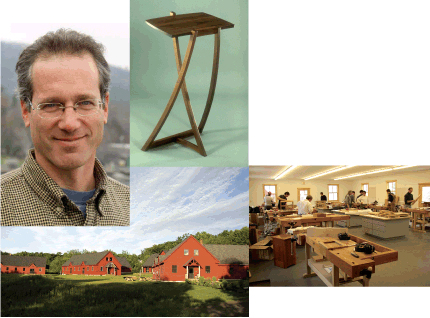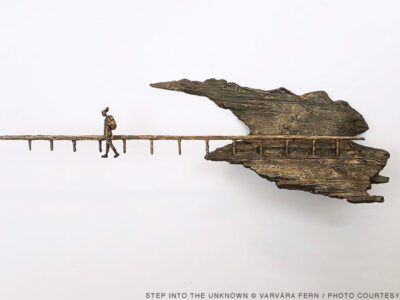
When Peter Korn C’72 decided to build a cradle for some expectant friends, he never imagined that he would discover a calling in the process. But the project proved to be a symbolic one; with it was born a passion to make furniture, and a prominent career in contemporary American woodworking.
The year was 1974. Korn was living on Nantucket, enjoying life as a carpenter and finding little use for his history degree.
“I loved what it felt like to be making things and seeing the results of your work, and inhabiting your body in a way you do when you’re working physically,” he recalls. But making the cradle had been an epiphany. “I’d been happily floating along in life until then, and even though the cradle was only a three-day effort, by the time I was finished, I had become this entirely different human being.”
Determined to pursue his new interest, Korn abandoned carpentry. At the time, teaching oneself to be a cabinetmaker was no easy proposition. The studio-furniture movement had yet to break; there were no woodworking magazines, no schools, and no instructional television programs. His task was to resurrect a lost art.
He learned rapidly, however, and before long his simple, graceful pieces began to sell. He eventually quit Nantucket for Maryland. After a year there, he moved to New York, where he opened a studio in Little Italy and took classes to perfect his drawing skills; then to the Hamptons, then to the Manayunk section of Philadelphia.
By 1986, his reputation established, Korn accepted a job as program director of a non-profit art center near Aspen, Colorado. He taught woodworking, and began work on a book, Working With Wood (later re-released as Woodworking Basics), which has since become a classic. But after six years he felt it was time to move on; the tony locale did not agree with him, and his own philosophy seemed increasingly at odds with the art center’s.
“It was about what’s held in esteem by the art world, where things are measured in terms of fame and money,” he says. “What I believe is that when people design and build furniture, they are making an important statement of what it means to be human, and how we ought to live.”
But working for a nonprofit organization had inspired him to open a school of his own, he says. “I wanted to create a place that honored the human activity of designing and building fine furniture out of wood, as something that was relevant, meaningful, very dignified, and very valuable to the people who practice it as an expression of the human spirit, and nothing else.”
Today, the Center for Furniture Craftsmanship occupies an 11-acre site in the picturesque countryside outside of Rockport, Maine. The center began life in 1993 in a decidedly humbler setting; classes first convened in the barn behind Korn’s house. The following year, in order to accommodate burgeoning demand, he rented space, but that too proved inadequate. In 1996, the school moved to its present location, and after a major fundraising campaign finally reached its current size in 2004. There are now workshops, studios, offices, a gallery, and a library. The barn-red buildings are low and simple, harmonizing with the local vernacular architecture.
The highly regarded center offers various programs, from a two-week basic woodworking course to a nine-month fellowship program. Classes are kept small by design, and the students—about 300 a year—have included a monk from St. John’s Abbey in Minnesota, a sculptor, and a corporate vice president.
As Korn walks through the workshops—complimenting some virtuosic dovetailing, gently correcting improper table-saw technique—it’s clear that he is happiest fostering an exchange of ideas among his students and inspiring in them his belief that, if approached as an art in its own right, furniture-making can transcend utility.
“People are now making furniture out of the same motivations that artists paint paintings,” he says. “They’re not doing it because it’s a trade, but because they want the experience of making it, and they expect to grow through the experience of making it. That’s the same reason people paint paintings or sculpt sculptures, and it’s the point of view underlying the school.”
—David Perrelli C’01




